
A Complete Guide To The Manchester Bee
Share
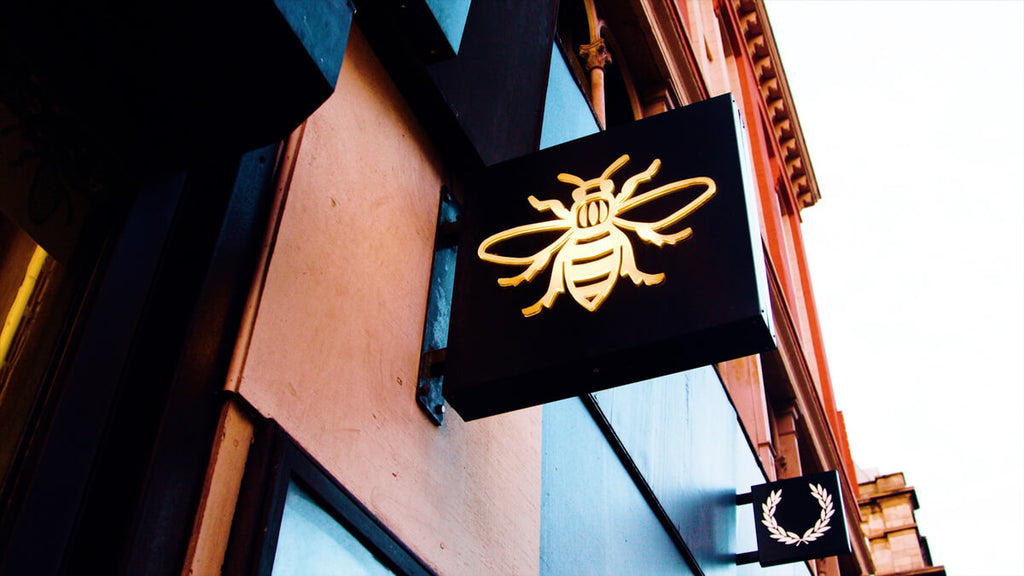
If you’re from Manchester, then there are not many places you can go in the city without seeing the iconic Manchester bee symbol. Our black and yellow buddy has popped up everywhere. But whether you’re from Manchester or not, you might not know what the Manchester bee symbolises.
Well, wonder no longer. We’ve put together this complete and comprehensive guide to everything you need to know about the Manchester bee!
We’re sure you’ll have a whole new love and appreciation for our little pollinating pals after reading through our Manchester bee deep dive…
Why does Manchester have a bee as its symbol?
Manchester began as a small market town, but that all changed towards the end of the 18th century when it became a hub for the industrial revolution and grew into the hive of industry we know it as today. It was the home of the first fully mechanised production process, where cotton was being imported through the canal from Liverpool before being processed in the mills of Manchester. The city’s damp climate meant it was perfect for milling cotton, leading the city to being affectionately nicknamed Cottonopolis.
We don’t usually associate a wet damp climate with the sunshine and flowers of bees though, so why was this symbol chosen?
Whilst Cottonopolis was thriving and quickly becoming the heart of technological and industrial change, factories and mills were cropping up all over the city. As the city began to bustle, many of the mills were nicknamed ‘beehive mills’ by their owners. They saw an obvious similarity between the ethics of the workers and a bee in a hive. These Mancunian factories were ‘hives of activity’ and what do you find in hives? The worker bees!
Another factor which undoubtedly contributed to the worker bee becoming synonymous with the city, is the fact that Manchester became the cradle of a new political concept, co-operation, in the nineteenth century. The beehive was used as a positive symbol of togetherness by the Co-operative Movement, and the Co-operative Group headquarters remain in the city today.
What type of bee is the Manchester bee?
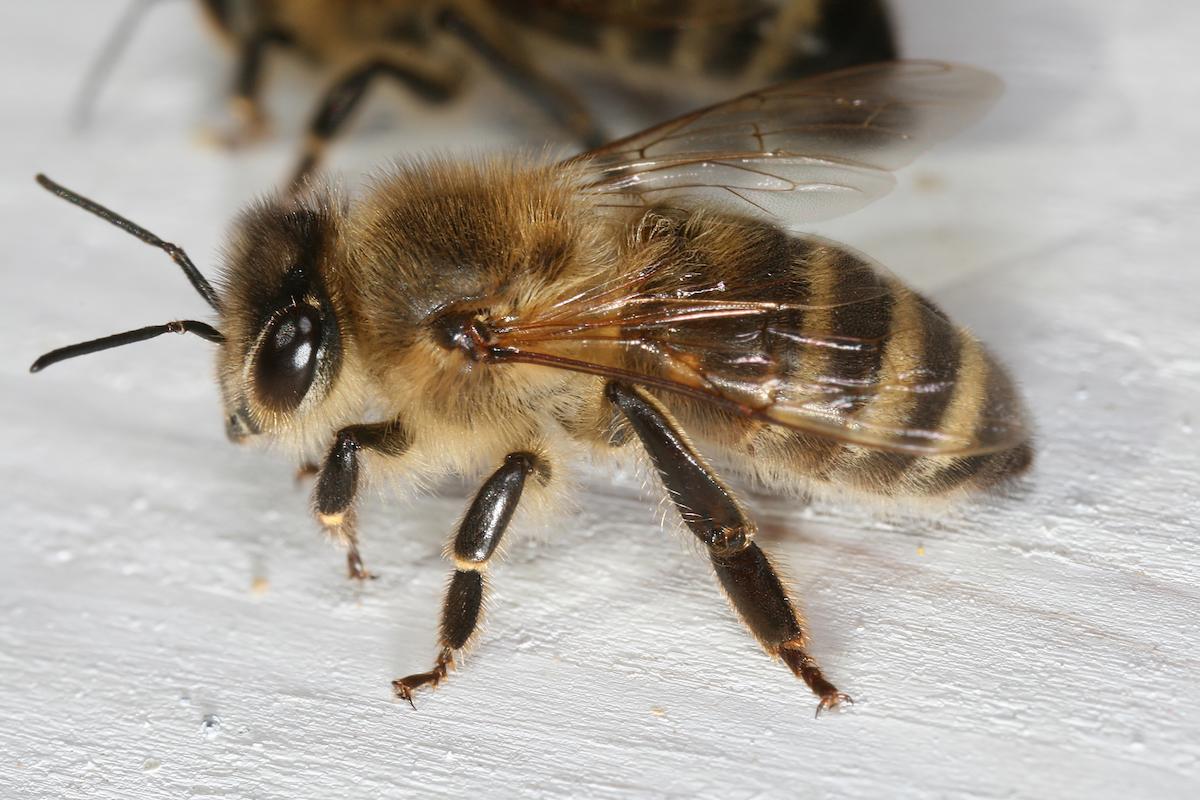
Frankie Roberto from Manchester, UK, CC BY 2.0, via Wikimedia Commons
The Manchester Bee is a worker bee. Worker bees are renowned in the animal kingdom as grafters, who work together to build a thriving hive. It also reflects the idea that the city was made by workers, it’s the people who make Manchester.
The worker bee is responsible for all the labour work of the hive, they gather food, protect the hive from predators and care for the young bees.
Worker bees do a significant amount of work within the hive all day every day, they work as a team. Based on this reputation, they’re the perfect symbol to represent the hard workers of Manchester during the industrial revolution right through to the present day.
Who designed the Manchester bee?
This question has stumped Manchester bee researchers and fans for many years, the truth is; no one knows! But there are a few things about the design that you see all over the city that make it pretty special.
You might have noticed that what makes the Manchester bee so unique is that it only has one set of wings rather than two and when it was originally placed in the coat of arms it had two sets of wings. When Manchester Town Hall was being built in the 1870s however, a simplified version of a worker bee with only one set of wings rather than two was mosaicked into the floor. It’s been speculated that this could have either been the idea of the town hall architect Albert Waterhouse or one of the italian craftsmen who laid out the flooring.
The one-winged design that was included in the mosaic floor stuck and it’s what became the bee we know and love today!
When was the Manchester bee created?
Way back in the 19th Century (the year 1842 to be exact), when Manchester gained city status, the early city fathers were tasked with creating a coat of arms that would tell the world who the brand new city of Manchester was.
Seven bees flying over the globe were featured on the coat of arms to symbolise Manchester industry being exported all across the world. The seven bees represent the seven seas.
Although the bee was well known for its ties between Manchester and the industrial revolution, usage of the bees as a symbol of Manchester dates back as early as 1810. The Independent Order of Oddfellows Manchester Unity (a fraternal order established by traders who were dissatisfied with the governing order at the time) used the beehive symbol as one of their emblems, “symbolising working together for the common good.”
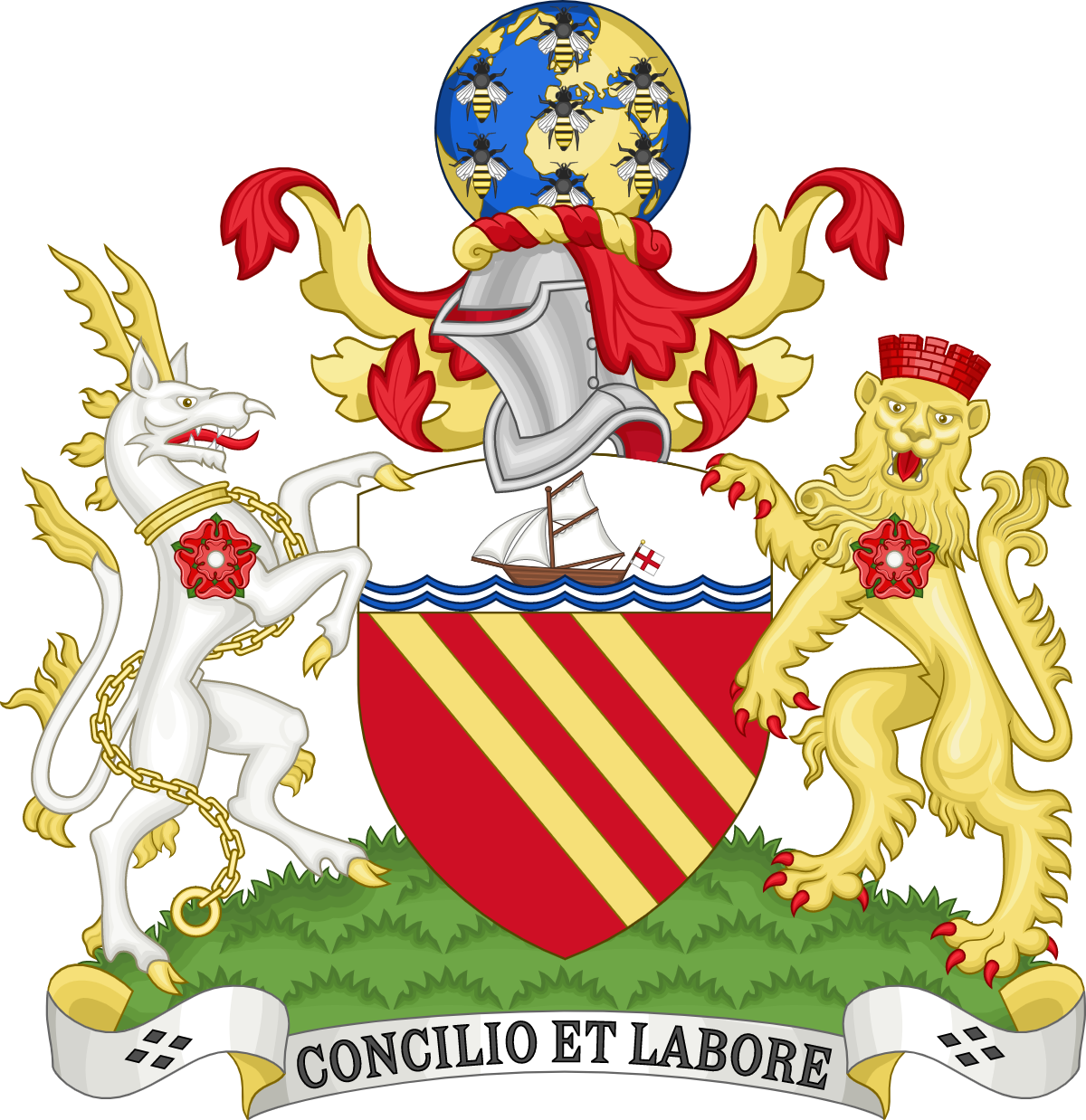
IndysNotHere, CC BY-SA 3.0, via Wikimedia Commons
The Manchester Coat of Arms also features the latin phrase Concilio et Labore meaning By Counsel and Work. This is derived from a Bible quote – Ecclesiasticus 37:16 “Let reason go before every enterprise, and counsel before every action.” Through counsel and hard work, by working together, we can achieve great things – just like our friends, the worker bees!
Love learning about the Manchester bee? Check out our History of the Manchester Bee collection of gifts.
Where can you see Manchester bees around the city?
Looking to see some bees around Manchester? Here are some of the most iconic places where the bees can be spotted…
Architecture
It makes sense in a city iconified by the worker bee, that they would be all over our town hall!
Manchester Town Hall first opened in 1877 and it was one of the first places the worker bee was integrated into the architecture. Inside the Great Hall there are bees on the roof and the mosaic floor. These beautiful mosaics truly are works of art and are worth seeing for yourself as well as the rest of this fantastic building. You’ll also be able to see bees in the coat of arms which is set in stone all over the town hall, the mantlepiece in the reception room and in stained glass windows.
The town hall is closed for refurbishment until 2024, but make sure you get down there when it reopens to see all the bees for yourself!
You'll also spot the bee symbol on other iconic Manchester buildings such as Manchester Central, Hotel Gotham, and on the Kimpton Clocktower Hotel (formerly The Palace Hotel).
Many of the historic mills and factories dating back from the industrial revolution have since found new uses. One of the most well known examples of these Victorian-era mills is Beehive Mill in Ancoats. Built in 1824, the former power spinning mill that helped bring mass production to the cotton industry, was used in the 20th and 21st century as the legendary nightclub Sankeys, and is now coworking spaces and apartments for the current worker bees of Manchester.
Although there are hundreds of hidden bees within Manchester’s architecture, you can also find most of them on everyday objects such as…
Bins
The bee bins were introduced in 2014 as an initiative to clean up the city centre. They have proven very popular with the residents of Manchester, so much so that in 2014 a proud Mancunian named George bought his very own for his home!
Since the implementation of the bespoke litter bins this year, proud Manchester resident George has admired the design and approached Wybone and Manchester City Council to have one of the bins specially made for his home. With special permission from the council, George can finally say he has his own piece of Manchester proudly on display in his kitchen!
George commented, “I was delighted when they sprung up around the city! I think the bin is a superb design and I like the modern representation of the Manchester Bee and its simultaneous resemblance to the Dior Bee!”
Bollards
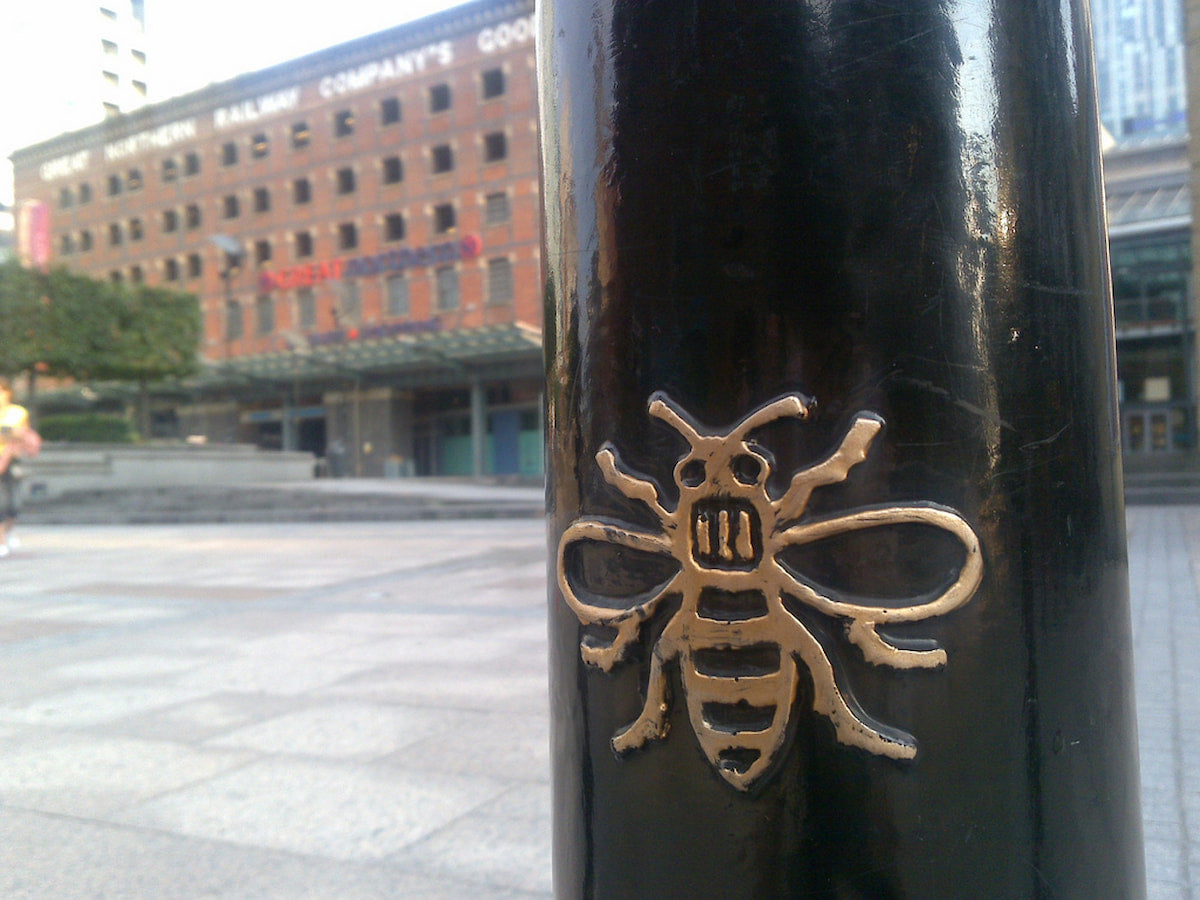
Frankie Roberto from Manchester, UK, CC BY 2.0, via Wikimedia Commons
The bee bollards date back to 1976 and were designed by Warren Marshall of Manchester City Council. You can spot these bollards dotted all over the city centre and further afield in Levenshulme and Chorlton. Based on the infamous Town Hall bee mosaic mural, there are some variations to the bollard bees in shape and colour (some are gold, some are silver, some have rings around them etc.) Have a wander around town and see how many different types you can spot!
Murals
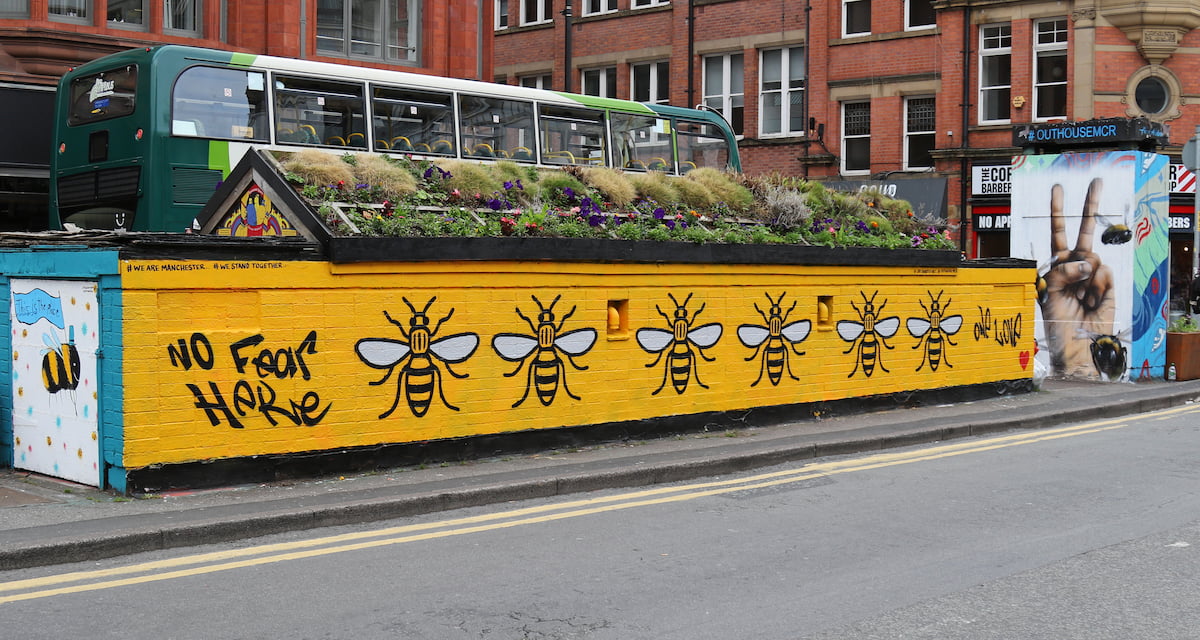
Transport Pixels from England, CC BY 2.0, via Wikimedia Commons
Some of the more contemporary and creative use of bees comes from spray paint murals dotted all over Manchester and the surrounding areas. A lot of inspirational street art popped up in the wake of the Manchester Arena attack in 2017, and although some of these pieces were unfortunately temporary, you can still see a lot of them today.
One of our favourite bee painters is Russ Meehan/ Mural Life. Creating realistic looking fuzzy bees on large scale, their work can be seen dotted around the Northern Quarter and Manchester, including Koffee Pot, the Ritz and even at our home in Afflecks!
Want to find out where you can see more? Gareth Hacking, a Manchester based photographer has been documenting the bees of the City Centre for over 10 years with his Manchester Bees Project, and has a whole section dedicated to the street art of Manchester.
Thinking of planning a Manchester bee tour around the city centre? Make sure you pop into The Manchester Shop! Situated in Afflecks right in the heart of Manchester’s bustling Northern Quarter, you’ll find a whole array of fabulous Manchester bee products, fantastic unique designs and super friendly Manc staff!
How is the Manchester bee related to socialism?
Manchester’s links to women’s suffrage is not the only example of radical thinking in the city.
It was in 1845 at the Reading Room in Chetham’s Library, that the founders of Marxism - Karl Marx and Frederich Engels - developed the foundation of their ideology. One of the results of these meetings was Engels’ revolutionary book The Condition of the Working Class in England, first published in 1887. Part of the the book documents his observations of the slums in Manchester, and in particular, the horrific child labour conditions unfolding in some of the cotton mills. This book then went on to influence Karl Marx’s most well-known work The Communist Manifesto, which was later recognised as one of the world's most influential political documents.
Although there is no evidence that there’s a direct link between this meeting of minds and the Manchester bee, lecturer in Sociology at the University of Manchester Richie Nimmo has written in depth about environmental sociology focusing on bees on his website Sociological Insect ~ On bees, humans & hybrids. His work on bee theory highlights the bee is a symbol of virtuous dedication to the collective good. Even if a Manchester worker bee isn’t specifically associated with socialism, it’s easy to see how the two could be related based on this ethos.
Are there really beehives in the city centre?
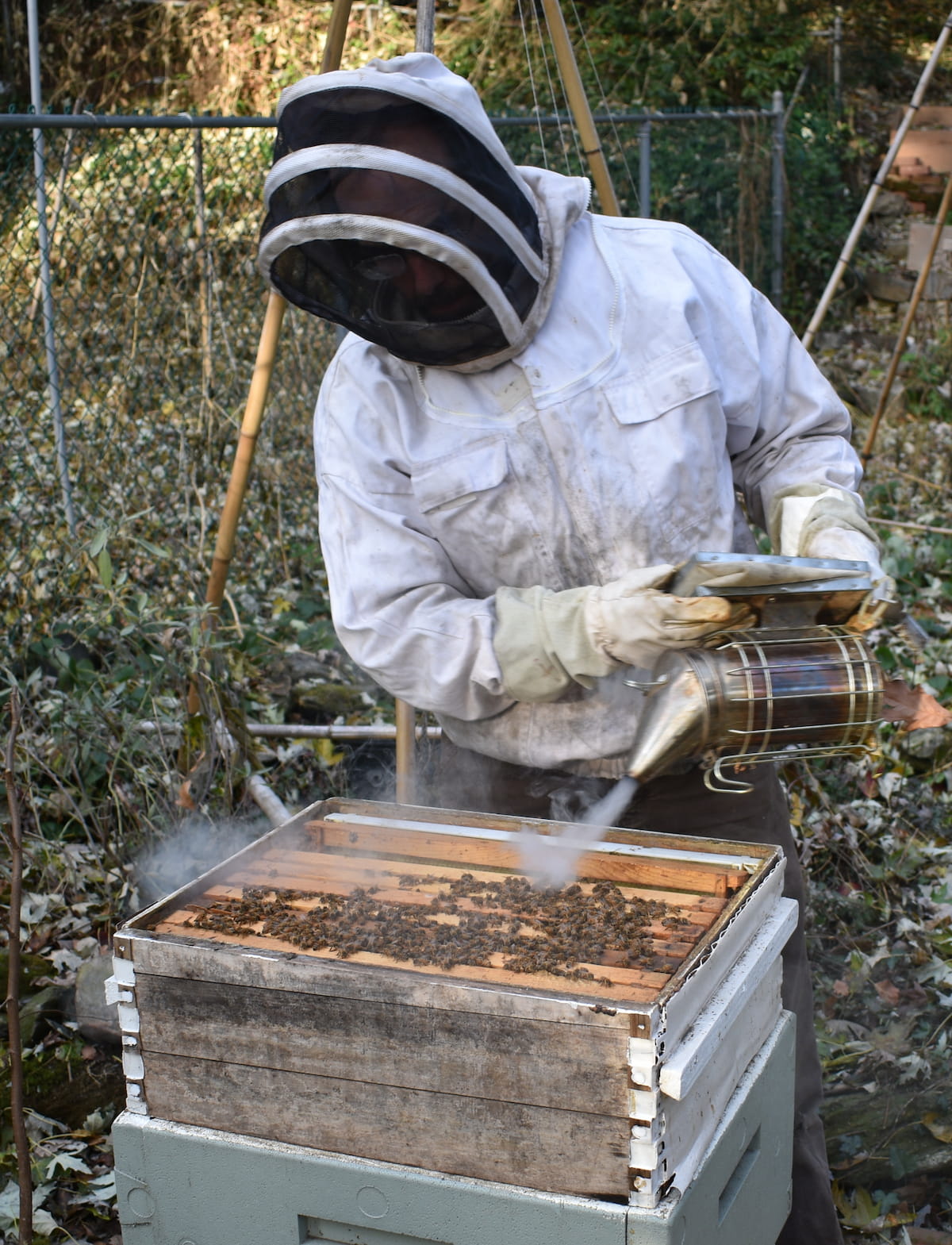
Ich, CC BY-SA 4.0, via Wikimedia Commons
Yes, really! There are plenty of hidden urban beehives spread across rooftops all over Manchester city centre. There are estimated to be hundreds of thousands of bees all working away making honey whilst you go about your daily lives!
In a space where urban development is growing rapidly and expanding out into Greater Manchester, it’s great to know that some creative Mancunians are finding ways to make our city centre space more biodiverse. Bees have a flight range of about two miles, so the honey they create in these hives is truly Mancunian!
Want to know where the bees live in Manchester? Here are some of the top hives that are absolutely buzzing…
Manchester Cathedral Beehives
Six beehives can be found above the entryway to our very own Manchester Cathedral, and it homes over 250,000 worker bees! These cannot be accessed by the public, but are taken care of by the “Canon Apiarist” at the cathedral and their produce can be sampled in the form of Heavenly Honey, available through the cathedral’s bookshop.
Printworks Beehive
The iconic Printworks building also has a hidden hive nestled on its rooftop. The hives were proposed by Bez from the Happy Mondays as part of a ‘adopt a bee’ project to raise money for local charity Forever Manchester. In 2015, the project was awarded a Biodiversity Hotspot Award by Manchester City Council. But bees aren’t the most unlikely thing you’ll find on the rooftop of the Printworks; it’s also home to six chickens!
HOME
More recently, HOME set up beehives in 2014 at part of their commitment to supporting biodiversity in Manchester city centre. On their rooftop on First Street there are two hives called Aldrin and Lightyear, as well as lots of other green-fingered garden essentials, including an old washing machine drum brimming with lavender to help the bees pollinate. Want to see what the bees are up to right now? There’s a video live stream on the HOME website!
Manchester Art Gallery Beehives
Like the folks at HOME, the staff at Manchester Art Gallery learnt all things beekeeping with the Manchester District & Beekeepers Association at Heaton Park before setting up the first hive in 2011, after being inspired by the hives at Tate Modern and Tate Britain. In partnership with Grow Wild UK, the honey created from their hives is used to create Brew Wild Beer.
Manchester Museum Beehive
Inspired by the traditions of their colleagues in the 80s, two bee hives were housed on the Manchester Museum roof in 2014 for the first time in over 30 years. The bees in these hives don’t produce a lot of honey, but what is harvested is then raffled off every year for charity.
Why is the Manchester bee so important?
As we have covered, the Manchester bee is considered a symbol of the city's industrial heritage, yet it isn’t used to celebrate the rich owners, produce, machinery or wealth generated from this time. Rather, the most essential part in all of it combined; the workers themselves.
As Manchester and Mancunians themselves take pride in living as one big community, the worker bee symbolises and reflects a spirit of togetherness and resilience, and represents the hard work, sacrifice and sense of unity.
This is important not just for those who live in and around Manchester, but also for those who have had to move away. Seeing a Manchester bee away from home is a reminder your community exists and will always be there, even if you’re not.
It’s also something for those who aren’t born and bred here to adopt as their own. We’re big believers that anyone who loves what we do in Manchester can be deemed an “honorary Manc” and we’re happy for them to make the Manchester bee their own. The bee is for everyone!
These little creatures have come to represent Manchester’s energy and solidarity. Resilient, peaceful, but with a sting in their tails.
Does the bee represent the Manchester bombing?
Although the worker bee has been used in Manchester since the industrial revolution, since the 2017 terror attack on the Ariana Grande concert at the Manchester Arena, it has come to symbolise the unity that bonded the city together when it was shook with grief.
One unique way Manchester demonstrated this unity was through solidarity tattoos. Mancunians and tattoo parlours across the city came together to offer free tattoos of the Manchester bee in return for a donation to charities that supported the victims.
Every year, the May 22nd marks the poignant anniversary of the Manchester terrorist attack. On this day, we usually see more people on social media using the Manchester bee as a symbol of unity to pay tribute to those who lost their lives, very often together with the hashtag #WeStandTogether.
When the 3rd anniversary came in 2020, it was made even more moving by the display of Manchester bees in people’s windows side-by-side with rainbows drawn to show support for NHS key workers during the first national lockdown.
Since 2017, the Manchester bee has become more than just the symbol of Manchester. It’s a way for fellow Mancunians to say without words that we’re together through thick and thin. Seeing the bee anywhere lets us know that that person or business is proud to be part of the Manchester community, and we’re standing together. It’s a sign of strength, safety and solidarity, and we’re incredibly proud of it.
Is the Manchester bee copyrighted?
Despite being emblazoned all over proud Mancunians in tattoo form, or used by local businesses as part of their black and yellow branding, Manchester city council hold the official trademark for the Manchester bee, including the iconic mosaic bee and the simplified modern-style bee.
If you’re looking to pay your own tribute with a bee tattoo or maybe a company logo, it’s a fantastic opportunity to get super creative and make something that’s completely unique to you! Why not use something that incorporates other bee iconography (honeycombs, beehives, honey) or come up with a fun and catchy bee-related tagline or slogan?
What was Bee In The City?
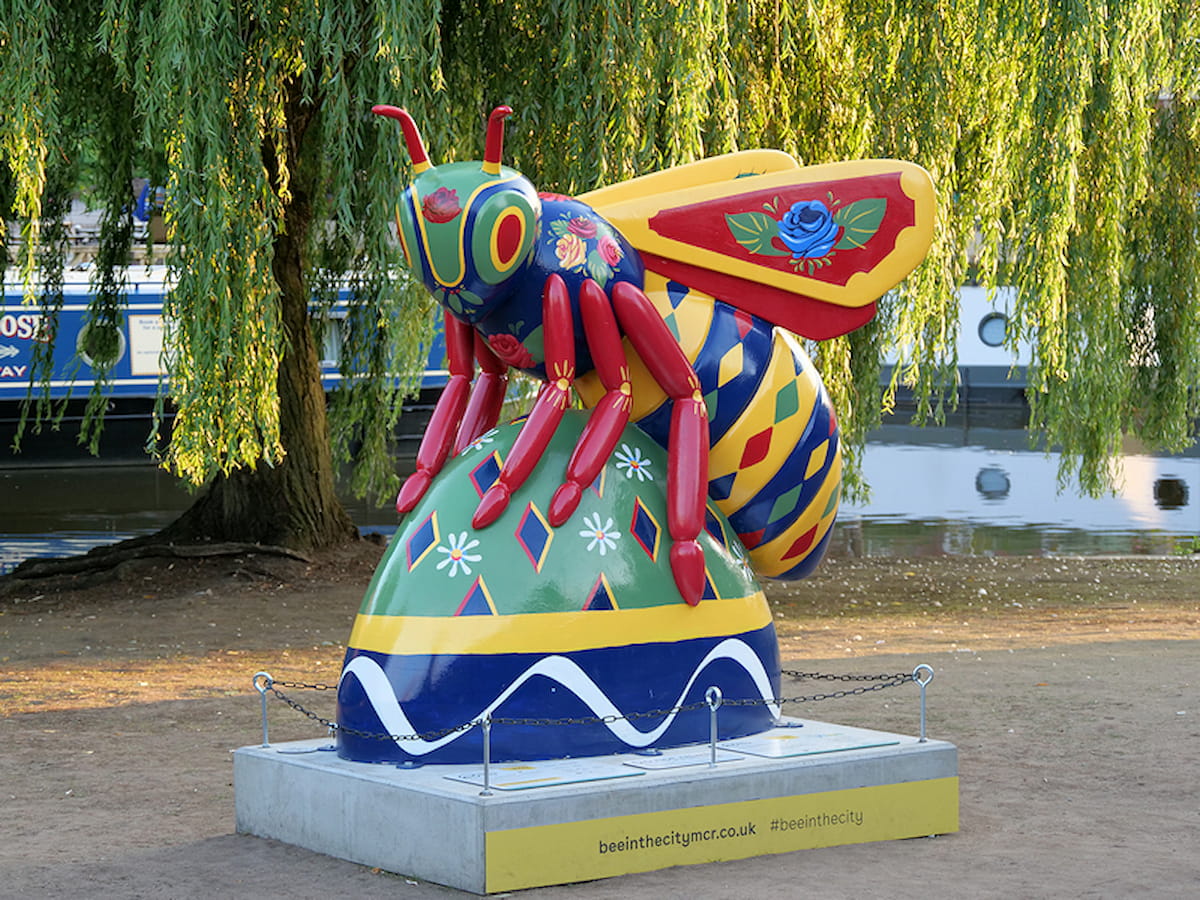
© Copyright David Dixon
If you found yourself wandering around Manchester in Summer 2018, you might have noticed something a bit different – we were taken over by some very big bees!
Bee in the City was a public art event which celebrated the iconic worker bee. In 2017, Manchester City Council approached arts group Wild in Art with the idea of creating a huge art trail that was free to the public and encouraged people from all over the world to take part.
By 2018 a colony of over 100 bee sculptures had swarmed the city of Manchester. Every bee was designed by a different artist and celebrated how unique Manchester is.
Each bee represented a unique part of Manchester’s heritage and achievements over the years. There were bees dedicated to the iconic music scene, football, scientific discoveries and even the industrial revolution!
The people of Manchester loved the incredibly creative artwork all over these bees. From the classic black and yellow Bee Here Now design featuring the faces of some of our favourite Mancs, to the Tony Wilson inspired Haç-BEE-enda (with the iconic “Sixth Day” quote on the wing), to Sylvia who is emblazoned with the colours of the Women's Social and Political Union.
The trail also included 131 ‘little bees’ which were designed by 121 schools and youth groups from all over the Greater Manchester area.
After the trail ended, 77 of these sculptures were sold at auction. This auction raised a whopping £1.1 million for the We Love Mcr charity, a foundation that helps to support and inspire Mancunians to make our city a fairer, safer, cleaner, friendlier place.
For more information about Manchester, please have a read of our article "What Is Manchester Famous For?".
Love all things Manchester bee? Check out The Manchester Shop for a massive collection of Manchester bee themed gifts and accessories, from bee mugs and tea towels, to bee earrings and bee keyrings!
